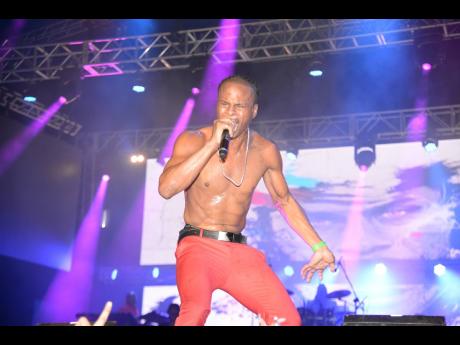Evolution of the male sex symbol in dancehall - From Shabba Ranks to Dexta Daps
The dancehall has always been presented as the ultimate playground for sex. Sexually charged lyrics and intimate moments between artistes and fans on stage have ruled the dancehall sphere since the ‘90s. Rexton Gordon also known as Shabba Ranks, declared himself a ‘bedroom bully’ in 1992, embracing dancehall’s salacious nature and laying claim to the sex symbol label.
Then in 2017, when Dexta Daps crowned himself the ‘owner’, he took the sexualisation of dancehall music to a whole new level. His raunchy ‘hold no bars’ interaction with his female fans have made him iconic, so much so that the title of sex symbol has also been bestowed on the entertainer. But what exactly was it that made these men sexual icons?
Music scholar Clyde McKenzie told The Sunday Gleaner that Shabba Ranks earned the title of sex symbol because he possessed the complete package. His voice, lyrical content, and swagger presented a combination that was considered irresistible to women. “There was a lot of bedroom banter and suggestions of his virility coming out in Shabba’s songs. He presented himself as someone who was able to deliver to the satisfaction of those who were privileged to have an encounter with him.
Presentation factor
“He presented himself as the type who could ‘deal wid things’ and navigate certain spaces comfortably (if you’re reading between the lines), and that kind of promise added to his appeal.” he said. “The lyrics, the swagger, the voice, the bravado - all of that created a package that said ‘here was somebody who was desirous’. Also, I think Shabba came into focus at a time when people were examining alternative notions of what was considered to be sex appeal. The ‘look’ of a Shabba was considered exotic, and it came at a time when people were paying attention to that (in the models that were coming to the fore, e.g. Grace Jones). Those who represented themselves different from the mainstream had some level of appeal, and so his swagger and everything represented something different, and many women at the time found it desirous.”
Addressing the evolution of the male sex symbol from the days of Shabba Ranks to Dexta Daps, McKenzie explained that while Daps has taken things to the next level as far as intimacy with female fans is concerned, sexual interaction between an artiste and his fans is not new. “Women were more discreet in years gone, but they would remove their underwear and throw it on stage so that sexual kind of involvement was always present. Sometimes, not very much changes but in different eras, certain behaviour becomes more in focus than in others.”
Professor Donna Hope agreed. She explained that the interactions between Dexta Daps and his female fans is an example of how the sexual form of communication has evolved.
“Shabba Ranks made himself into a sex symbol and he was very attractive to women because he celebrated them. He sang a lot of songs praising them. He was one of the leading artistes of his time, but one of the things that’s different about Dexta Daps is that he’s very sexual in his performances. There’s a lot of tactile activity where he’s involved. He allows people to touch him, rub up on him. He carries them on stage and the sexualisation becomes more personal. He removes his clothing and makes himself more appealing to women so it’s not just his music,” she said. “That song (Owner) that he sang (with that video) it was the next level. Everything has gotten more intense, more extreme, more graphic and more colourful. We all went to Sumfest that year to see him and for him to be the ‘owner’. I remember he had on a little yellow suit and he tore off the jacket, and people were just going crazy. That song set him up in a very real way to be the current sexy symbol.”
Passing of baton
Gussie Clarke, veteran producer who worked on a few of Shabba Ranks’ songs, described Shabba as the man who took over the sexualisation of dancehall from the likes of Yellowman and General Echo and said that Dexta Daps is continuing on the foundation laid by Ranks.
“He (Shabba) brought a little bit more sexiness and a little more class to it (the sexualisation of dancehall) plus his performances were compatible with what he was singing and that made a whole lot of difference when he was compared to those who were singing a lot of the same things. It’s the same for Dexta Daps.
Anybody can talk about sex but if you have the look and the image, what you’re selling will become more attractive to consumers,” he said. “Dexta Daps has taken it to another level and improved on the work of Shabba Ranks. He’s a lot more intimate than Shabba was and people embrace that.
“He’s a smoother, cooler, younger person, so he’s for this generation. And the fact that the world is much more sexual now is working in his favour. The kind of music he’s putting out is also more compatible with what is being released globally, and so he’s obviously knows what he’s doing and it’s working.”
Clarke, Professor Hope and Clyde McKenzie all believe that as music continues to evolve, so will the image and sexual limitation of the sex symbol. Dexta Daps may be the standard right now, but as music continues to go through changes, the face and style of the next generation of sex symbols will, too.





